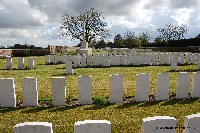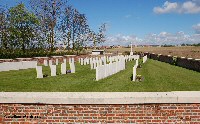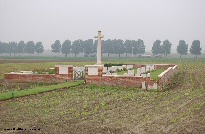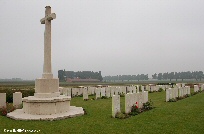Villages East/North-east of Ypres
Potijze, St. Jean & Wieltje
The World War One Battlefields site is undergoing a major update, with pages being converted to a new, user-friendly mobile format. The updated pages can be found at Updated World War One Battlefields. Some pages such as this one remain in the original format pending update.
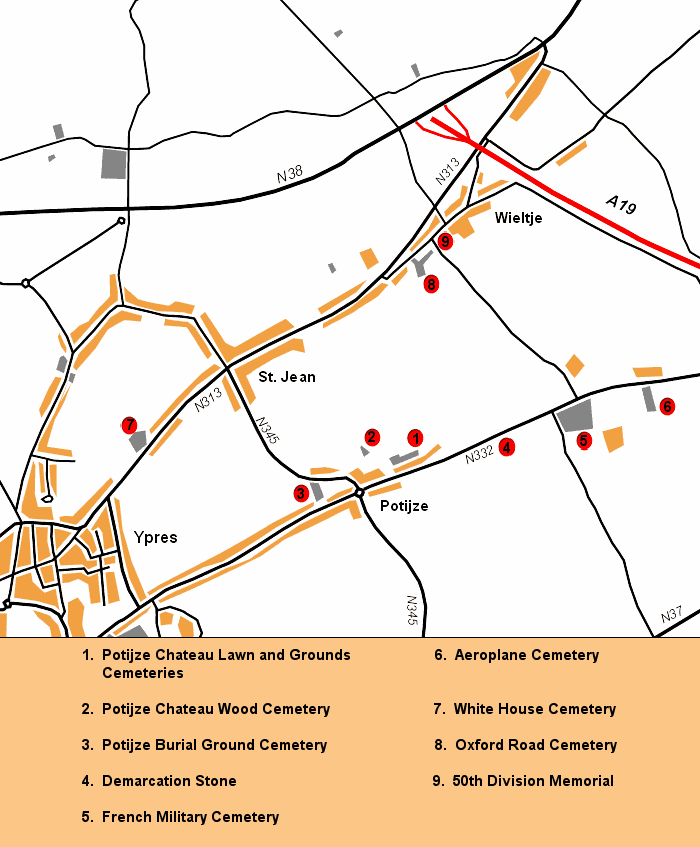
Map showing sites in villages east/north-east of Ypres
Potijze
This small hamlet, now really a suburb of Ypres, is found on the N332 just to the east of the city. There seem to have been a number of variations of how the name is spelt; it is a real tongue-twister, and for the British soldiers serving there the pronunciation and correct spelling cannot have been obvious. In fact, although all four cemeteries in the vicinity have the name spelt as Potijze in the registers (and also on the CWGC website), the name inscribed on the stone pillar at Potijze Chateau Wood Cemetery is spelt Pottize! Yet another variant is used at the French cemetery nearby.
The village was held by the British for most of the war, and an Advanced Dressing Station was established in the grounds of Potijze Chateau, with cemeteries being made around it for those who died. However, the area was closer to the front line during the Second Battle of Ypres in April/May 1915, and at that time the Chateau was used as a headquarters by the 27th Division. Very near to where the Chateau stood, on the 29th of May 1915, the Germans attacked using lachrymatory shells. Strong resistance by the 3/Royal Irish Fusiliers held them off however.
There are four cemeteries within the village; three are close together, based on their original location by the Chateau. They are reached by following a small cinder track, which is signposted with green CWGC signs, in between houses to the left of the N332 leading out of Ypres, just after the roundabout where the N332 crosses the N345.
The first two cemeteries reached give the appearance of being just one. These are the Potijze Chateau Lawn Cemetery and Potijze Chateau Grounds Cemetery.
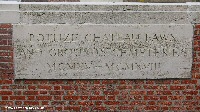
Entrance to Potijze Chateau Lawn and Grounds Cemeteries
Potijze Chateau Lawn Cemetery is the lower tier, to the left, as you enter, whilst Potijze Chateau Grounds Cemetery is the upper, and larger, portion to the right. The cemeteries were both started in May 1915, and Grounds Cemetery was used right through until September 1918. Lawns Cemetery was mainly used in 1915, but also briefly in 1917 and 1918. The burials from 1917 however are the majority. At the end of the war, Grounds Cemetery was made up of Plot 1 only - which is the furthest away from Lawns Cemetery. There would then have been a clear disctinction between the two. After the Armistice, graves were brought in to make up Plot 2 in Grounds Cemetery, meaning there is now no gap between the two.
Potijze Chateau Lawn Cemetery contains 226 graves and Grounds Cemetery contains 476 burials. There are a number of special memorials to men known to be buried here at the back left of Grounds Cemetery.
I have a series of postcards that illustrate the changes in these cemeteries over many years. The first, which must have been taken very shortly after the war ended, does not actually identify the cemetery by name; but thanks to help on the Great War Forum, it has been possible to identify it as Potijze Chateau Grounds Cemetery. The ruins of the chateau can be clearly seen in this picture (no trace of these remains today).
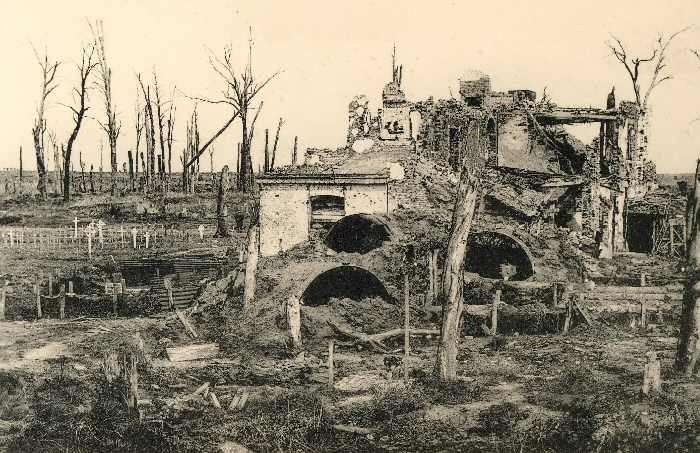
Potijze Chateau Grounds Cemetery just after the War Photo: NELS
The next picture was probably taken at a not too long afterwards, but from a different viewpoint. The sign in the picture gives the name of the Cemetery, complete with map reference. The original crosses, mostly uniform, can be seen in rows, and the small sign states this is plot 2 - the graves brought in after the Armistice.
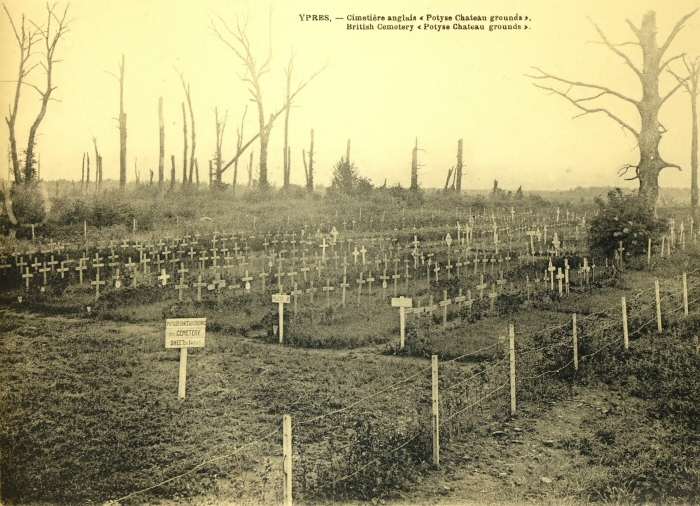
Plot 2 of Potijze Chateau Grounds Cemetery shortly after the War Photo: Van Winsen
It is possible to compare todays view from this exact spot; as shown in the photo below (which can be enlarged for comparison by clicking on it). The change from devastated land and sometimes crooked crosses to the neat, regular appearnce today is a testsament to the work of the CWGC (and previously IWGC) in constructing and manitaining these cemeteries.
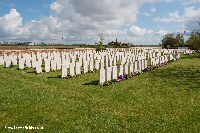
Plot 2 of Potijze Chateau Grounds Cemetery today
Finally in the sequence is a postcard which may date from before the Second World War, or possibly afterwards. This shows a view from the far end of the Grounds Cemetery, looking past the Cross of Sacrifice to the lower Lawns cemetery. The IWGC permanent headstones are all in place; the walls have been constructed, and the view compared with that of today (below) is very similar. Time has allowed the large tree right by the Cross of Sacrifice to grow and mature, and also the one French grave (in the form of a cross) at the back near the wall does not seem to appear in the black and white picture.
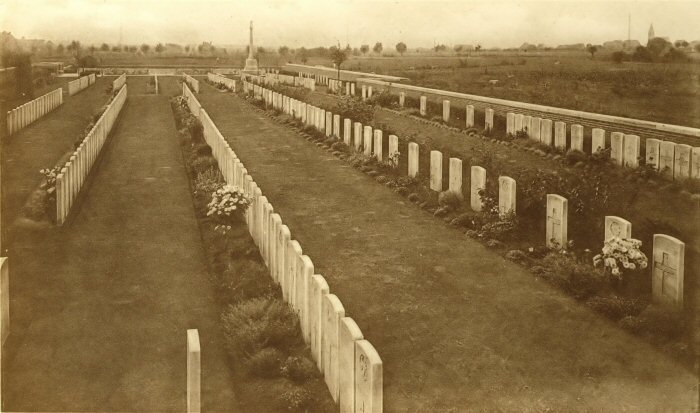
Potijze Chateau Grounds and Lawn Cemeteries possibly between the wars Photo: NELS
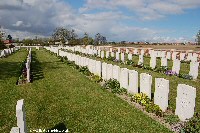
A similar view of Potijze Chateau Grounds and Lawn Cemeteries today
As well as being on a lower tier, the graves in Lawn Cemetery to the left are set at right angles to those in Grounds Cemetery.
Another of the very early postcards may show Lawn Cemetery, or this may possibly be another view of Grounds.
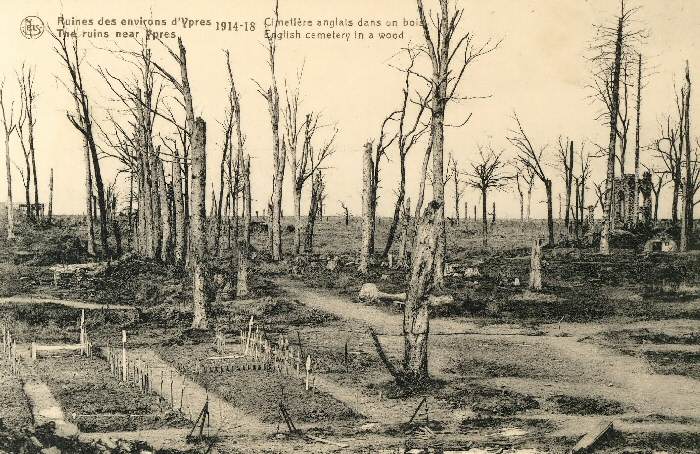
Potijze Chateau Grounds or Lawn Cemetery just after the War Photo: NELS
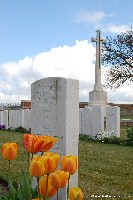
Potijze Chateau Lawn cemetery today
A track from the back of Lawn Cemetery leads leads left and then right around the edge of a field to another war cemetery.
Potijze Chateau Wood Cemetery is the earliest of the three "Chateau" cemeteries, started in April 1915 and used until June 1917, and briefly in 1918. At the front left are two long rows of graves set very close together - all of 2/Hampshire men killed on the 9th of August, 1916. For example, there is William Atherfold of D Company, killed aged 19, and Private David Sheen, who was aged 22. On the night of the 8th/9th August 1916, the 2nd Hampshires were in trenches near Potijze. The first few days of August had been quiet, and they worked to improve the defences in this area of the line. But that night, the gas alarm was sounded and the light wind from the north-east carried a cloud of gas across their trenches, which took about an hour to pass over. The Germans did not follow-up with an attack however, although this may have had something to do with British artillery support that fired shrapnel shells onto their positions. The 2nd Hampshire War Diary describes the gas as "a particularly deadly kind", and noted that it corroded metal and also killed rats and birds. It was certainly deadly, as 4 officers and 125 other ranks died, and the battalion relieved by the 1st Essex the following night. Some of those who died that night were buried together here, and this explains the two long rows of headstones which can be seen in the photograph below.
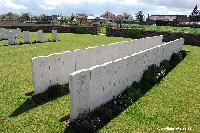
Hampshire men, side by side at Potijze Chateau Wood Cemetery
Overall, there are 157 soldiers buried here, all but six of whom are identified. The Cross of Sacrifice is set at the far end of the cemetery in a bed of beautiful shrubbery.
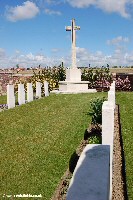
The Cross of Sacrifice at Potijze Chateau Wood Cemetery
There was a committee formed after the war, the Chateaux and Historic Sites Society, with the intention of preserving certain battlefileds in Belgium, and Potijze Chateau was one of the sites that was to be preserved. Obviously, this never happened, and the ruins of the Chateau are long gone.
The fourth cemetery located within the village is Potijze Burial Ground Cemetery. Returning to the main road (N332), and back towards Ypres, at the roundabout turn right towards St. Jean (today signed as Sint-Jan) on the N345. Potijze Burial Ground is on the left side of this road on a bend. This cemetery was used from April 1915 to October 1918, and there are nearly 600 Commonwealth burials of the First World War here.
Once again, I have pictures showing the cemetery over time. The early photo below, dates from shortly after the war. It shows the road in front of the cemetery as it was then, and the cemetery itself actually looks quite overgrown. It can be compared with the neat appearance today, although due to the road and the wall now in front of the cemetery it is not possible to catch the exact angle of the original.
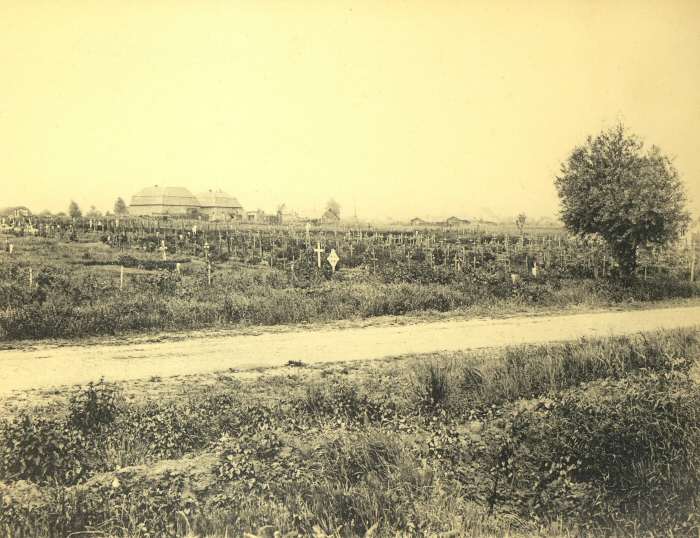
Potijze Burial Ground Cemetery shortly after the War Photo: Van Winsel
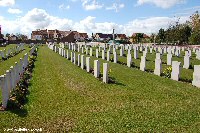
Potijze Burial Ground Cemetery today
A later postcard shows another view, and below is a similar view of the cemetery today.
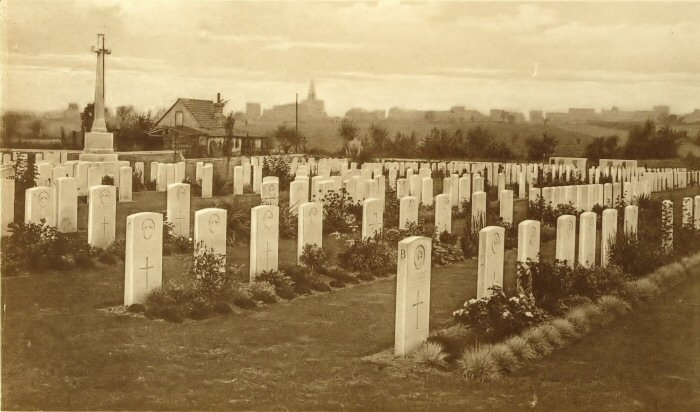
Potijze Burial Ground between the wars Photo: NELS
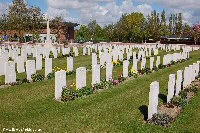
Potijze Burial Ground Cemetery today
On the modern view, when enlarged, the fourth grave along on the has a small framed picture at the base. This is a picture of the soldier who is buried there - Guardsman Alfred Ernest Atkinson, of the 4th Grenadier Guards, who died on the 11th of April 1916, aged 23.
This cemetery is quite large, and it can be all too easy when gazing across the ranks of headstones to forget that each one represents a man who died somewhere near here. Seeing this young, open face, looking directly at the camera, makes you remember.
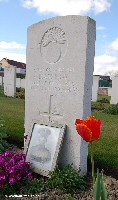
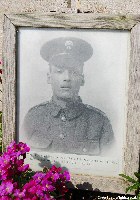
The grave of Guardsman Alfred Atkinson, and his photo beside it
Here at Potijze Burial Ground there are again many burials from the 2nd Hampshires, of men killed on the 9th of August 1916 (as at Potijze Chateau Wood Cemetery, see above). In row T, at the front left of the cemetery, the headstones are very close together - touching, in fact - and there are 17 headstones. One in the centre bears a cross alone, and the eight on either side of this each bear two names. Therefore, 32 men were buried here side by side in a mass grave (the single stone in the centre of the row with the cross is there because with two names engraved on each stone there is no room for the cross). There is a similar but smaller row behind (row U), but with the same layout - seven headstones, one with a cross alone in the centre and three either side. Most again have two names, but the stones at either end of the row have three names each.
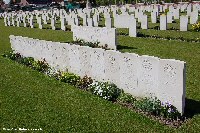
2/Hampshire soldiers buried at Potijze Burial Ground Cemetery
Potijze was the scene of an advance on May the 13th 1915, by the Essex Yeomanry and the 10th Hussars. In The Battle Book of Ypres, Beatrix Brice records how Major Andrew Roddick, of the Essex Yeomanry, led the advance with "his pipe between his teeth, his stick in his hand". The attackers took the German trenches and held on until evening, but then had to retreat. Major Roddick was killed, and another casualty was Serjeant Lionel Deakin, reported to be shot as he stood firing, and due to the numbers in the trench his body stiffened in death in the position of still firing at the enemy. Both men have no known grave; both are commemorated therefore on the Menin Gate.
One of the Demarcation Stones erected after the war by the Ypres League can be found near Potijze - on the N332 a little further away from Yprs, and more or less opposite a building which houses Picanol Research.
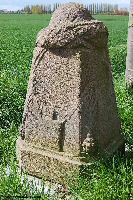
Demarcation Stone near Potijze
A little further out on the N332 east out of Ypres, are two further cemeteries. The first reached is is the French Cemetery, St. Charles-Potyze Cemetery, to the right hand side of the road, over which the French and Belgian flags both fly.
The register can be found in a box on the right side of the entrance, and just inside the cemetery is an information board, which gives details of the battles fought in Flanders in 1918, and also on French war cemeteries. Another is not far away on Mont Kemmel, and there are early pictures of both the Potijze and Kemmel cemeteries and also wartime photographs of the devastated landscape.
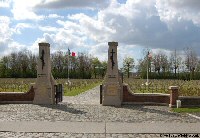
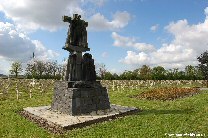
St Charles-Potyze French Cemetery and the sculpture within it
The French cemetery was started during the war, but the majority of graves were concentrated here after the Armistice from many other cemeteries. Within the cemetery is a sculpture depicting a mourning mother and a crucifix. Burials have very recently been made here, with four unidentified French soldiers buried here in April 2006. Their remains were found the previous October, near Pilckem.
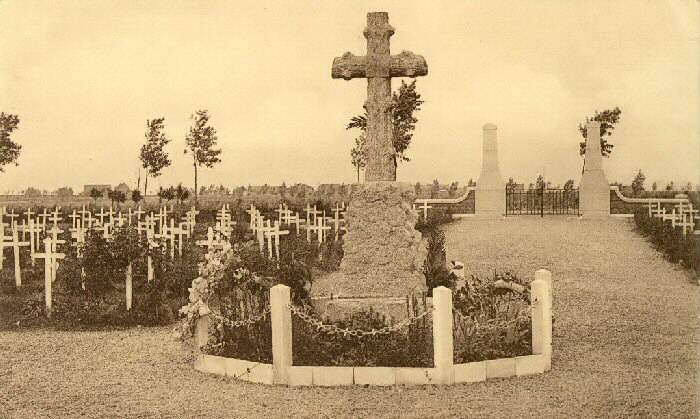
An early picture of St. Charles-Potyze Cemetery Photo: NELS
A little further along the N332, again travelling away from Ypres, is Aeroplane Cemetery, so named because during the war the wreck of an aeroplane once lay here. It was originally called New Cemetery, Frezenberg and is located on the right hand side of the road opposite a garden centre. There was originally another cemetery with the same name at Fricourt on the Somme, but the graves there were relocated after the War to Dantzig Alley Cemetery, also at Fricourt.
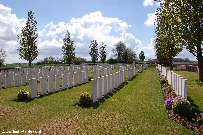
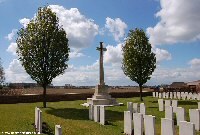
Aeroplane Cemetery - the wreck lay near where the Cross of Sacrifice now stands
The earliest burials here are from Third Ypres, and there are special memorials (to men believed to be and known to be buried here) located at the front of the cemetery on both sides. The original cemetery is now part of Plot 1, towards the rear where the graves are noticeably less regular. Some of the graves in Plot 1, and in the more regular plots nearer the road were brought here after the Armistice. Over 600 of nearly 1,100 soldiers buried here are unidentified.
St. Jean
Now called Sint-Jan, this small village is on the outskirts of Ypres, lying to the north-east of the city on the N313.
White House Cemetery is located on the left-hand side of this road as it leads out of Ypres. An interesting series of photographs shows this cemetery over time. The first one was probably taken early in the 1920s. The original wooden crosses mark the graves, but the cemetery wall has been constucted, and both the Cross of Sacrifice and the Stone of Rememberance are in place. The second, which may have been taken only a little later, shows the cemetery with nearly all the crosses replaced by the standard IWGC headstones. A noticeboard has been placed just to the left of the cemetery gate. The third view shows the cemetery today; the noticeboard has gone, as has the small tree which stood in front of the cemetery. An unavoidable addition to this picture was a Mercedes parked in the small layby next to the cemetery!
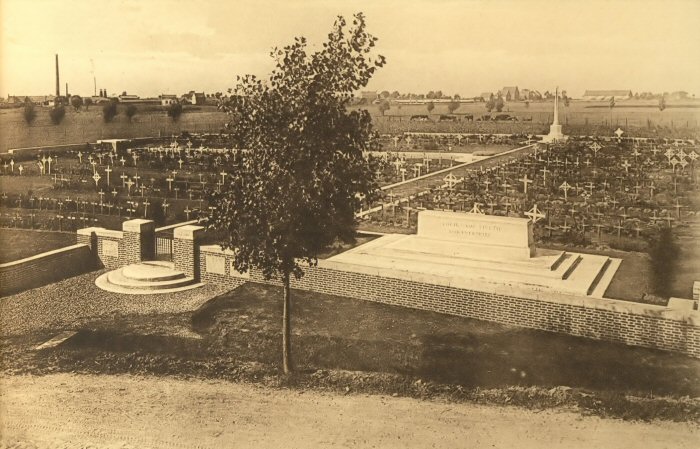
White House Cemetery with wooden crosses still in place Photo: NELS
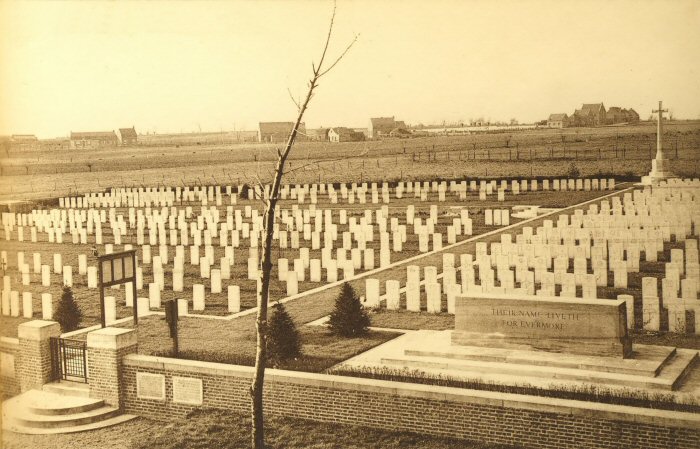
White House Cemetery with most crosses replaced by headstones Photo: NELS
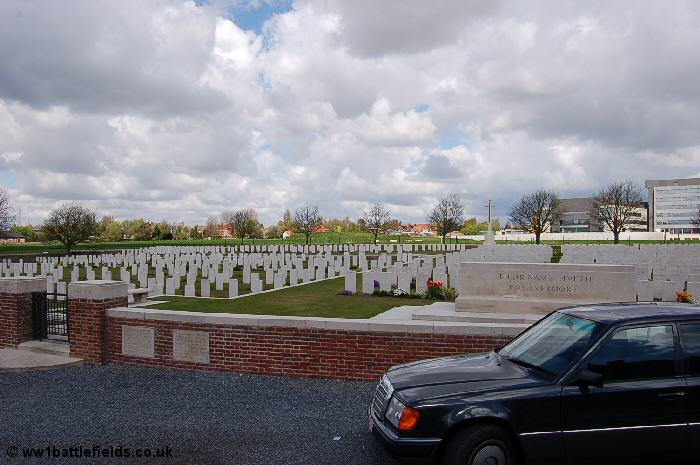
White House Cemetery today
Right behind the cemetery is a large new office block. The cemetery is set on two levels, with Plots 1 and 2 (probably the original graves) on the left. Plot 3 is set higher on the right, and Plot 4 at the back left. There are special memorials located at the front and on the left side.
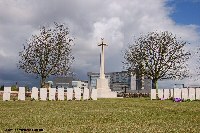
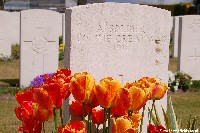
White House Cemetery: new office blocks but beautiful flowers
The cemetery was started in April 1915, and used almost throughout the war until April 1918. Other graves were then brought here after the Armistice. One headstone here, in Plot 3 Row B grave 20 was broken at the base and lay on it's front when I visited most recently in May 2006. I tried to raise it slightly to see the name of the soldier who was buried here, but it was incredibly heavy, and I could not lift it even a little. Whether it was broken by vandalism or some other cause is unclear, but I have alerted the CWGC to this. Altogether, there are over 1,100 burials here, including eight from the Second World War. There is also one Belgian grave.
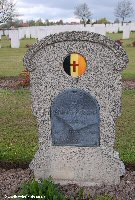
Belgian grave at White House Cemetery
Wieltje
This village lies a little further north-east than St. Jean, and nowadays is straddled by the A19 motorway.
On the left hand side of the road out from Ypres, the N313, and just before the turn for Oxford Road Cemetery (see below) is Wieltje Farm Cemetery. The cemetery is reached by a grass track from the road which runs between buildings. The large and busy N38 road runs in the background across the fields where the cemetery is located. Just inside the gate on either side are special memorials to men known to be buried in the cemetery, ten on the left side and nine on the right (although one stone commemorates two unknown soldiers from the Loyal North Lancs Regiment). Their graves were destroyed by shellfire.
There are just three rows of graves and the reigster box can be found at the far end of the cem. There is also one German grave here, located at the end of the cemetery by itself. The cemetery was used for just a few months - between July and October 1917. One interesting burial here is Private Winstanley Carlyon-Britton. The register states that he was the eldest son of Major Philip Carlyon-Britton, was educated at Harrow, and had formerly served as a Lieutenant in the 5th Royal Dublin Fusiliers. However, he was serving as a private soldier in the 2/5th Leicesters when he was killed in action on the 26th of September 1917. On that day, the battalion were attacking near Dochy Farm which is a little south-west of s-Gravenstafel, and two or three miles from where he is buried.
An entry in the Harrow Roll of Honour gives some more details on Winstanley Carlyon-Britton: he served with the Army before the Great War, firstly in the Special Reserve as a Second Lieutenant in the Royal Fusiliers. He joined the Royal Dublin Fusiliers in 1910, and resigned his commission in 1912. On the outbreak of War, he was appointed as a Second Lieutenant in the Worcestershire Regiment, but, the Roll of Honour states, "was invalided out early in the War and totally exempted from further service". However, after months of rest he felt better and wanted to serve again, but rather than try for a commission he re-enlisted as a Private soldier. He joined the Leicesters in November 1916, and was in France with them by February 1917. Ironically, he had just been reccomended for a commission when he was killed in action (the Roll of Honour states on the 25th of September), acting as a runner to an advanced post.
Oxford Road Cemetery is reached along a small road leading off to the right from the N313 a little before the motorway. Oxford Road was the name given to a road which ran behind the lines. The cemetery is irregularly shaped, with three "arms", the Cross of Sacrifice being set in the centre of these, and the story behind the cemetery is of interest. There were at one point two small cemeteries, located close to one another; firstly the original Oxford Road Cemetery started in August 1917 (now Plot 1, which is towards the far end of the left-hand "arm", by the Stone of Remembrance). Two months later, in October 1917, another cemetery was started close by, known then as Oxford Road Cemetery No. 2. These graves now form Plot 5 of the cemetery, towards the rear of the upper "arm". After the Armistice graves were brought into the cemetery to make plots 2, 3 and 4, effectively joining up the two original smaller cemeteries into one larger one.
As with several other Salient cemeteries, I have old postcards which show the cemetery at various times. The first shows it probably in the early 1920s, as the graves are in Plot 2 which was one of those formed by graves concentrated here from elsewhere after the Armistice. Most of the graves are marked by the standard IWGC cross - not altogether surprising as they were moved here from elsewhere. On the left however can be seen a large white cross. This actually has two names on it - A. Richardson and H. Panter. In the same view today (below), it is not possible to read the names on the individual graves at the same distance.
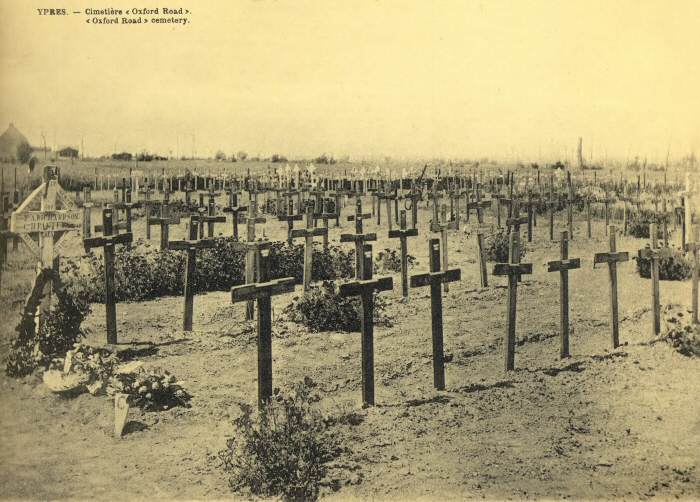
Oxford Road Cemetery shortly after the War Photo: Van Winsen
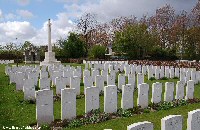
The same view at Oxford Road Cemetery today
There are many cases of headstones bearing two (or more) names in CWGC cemeteries. But today, the graves of Bombadier A Richardson and Gunner Henry Panter are marked by two seperate headstones, denoting two separate graves.
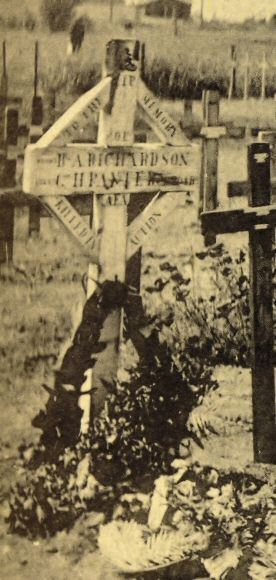
Single grave, with the names of both Bombadier Richardson and Gunner Harry Panter shortly after the War Photo: Van Winsen
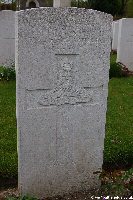
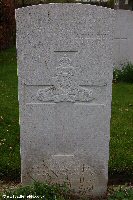
The graves of Bombadier Richardson and Gunner Harry Panter today - marked by two seperate headstones
It is possible to speculate why there should have been one grave marker then and two separate ones now. Both men were part of the same unit - "C" Battery 104th Brigade, Royal Field Artillery - and both died on the same day, the 6th of July 1917. As they lie in a part of the cemetery (Plot 2) which was formed by bringing in of graves from other areas, they were possibly originally buried together in one grave after they were killed, and the grave marked with this original cross. When the bodies were moved to Oxford Road Cemetery, the cross may have been brought and initially put up, but the men buried in individual graves and the cross later replaced by two headstones.
However, there are other possibilities. Perhaps both men are in fact buried in one grave here at Oxford Road, and the current headstones (very regularly laid out in this part of the cemetery) are not in fact exact markers of their individual graves. I would think this a less likely explanation, but at this distance of time we will never know the true answer.
What is certain is that these two men gave their lives for their country and were mourned. The inscription on Gunner Panter's grave today reads "Be still and the charm of his life will re-echo once again". Henry Charles Panter (recorded in the 1901 census as "Harry") was just 21 when he died. His family lived in Church Lane, Charlton in Greenwich, London, and the family must have been quite well off, as Harry's father, Henry Thomas Panter, was recorded as a Dairyman with employees and also a servant. In 1901 Harry had a younger sister, Jessie.
The picture below shows a later view of Oxford Road Cemetery, looking from Plot 5 towards the Cross of Sacrifice. The photograph beneath that shows the cemetery as it is today. There are a few differences; the trees surrounding it are obviously much more mature, and in the early picture the loggia building on the left had not then been built.
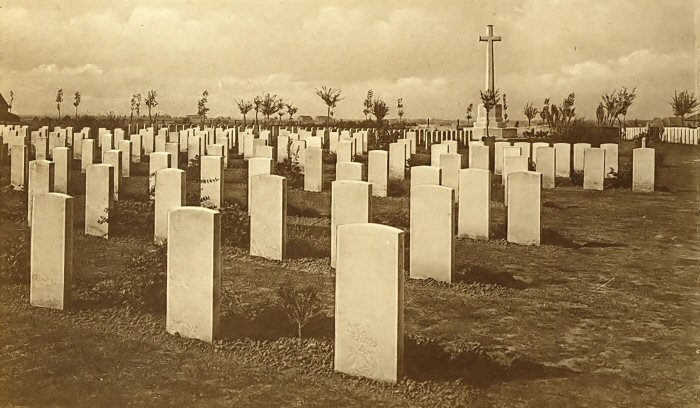
Oxford Road Cemetery perhaps between the wars Photo: NELS
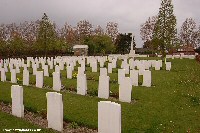
The same view at Oxford Road Cemetery today
In total there are 851 soldiers buried or commemorated here, with over a third being unidentified. The 50th Division Memorial can be seen rising tall beyond the cemetery.
The 50th (Northumbrian) Division Memorial is reached by following the road just a little further along, heading away from Ypres. It is a tall, substantial and impressive obelisk, some 55 feet tall, and visible from quite some distance especially from the south. The memorial is set within a low wall within a lawned area, entered by a gate set in stone pillars, somewhat similar in appearance to many CWGC cemetery entrance gates. There are the stumps of four trees at the corners of the walled area.
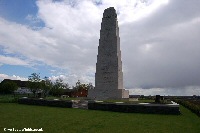
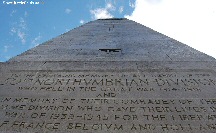
The 50th (Northumbrian) Division Memorial
On the front, at the base are the words "Pro Patria". The main inscription above reads "To the enduring memory of all ranks of the 50th Northumbrian Division who fell in the Great War 1914-1918 and in memory of their comrades of the same Division who gave their lives in the War of 1939-1945 for the Liberation of France, Belgium and Holland". Above this is the Divisional emblem, two capital letter T's, signifying the Rivers Tyne and Tees. A sword is engraved above, with a representation of a horses head looking out from laurel wreaths right at the top.
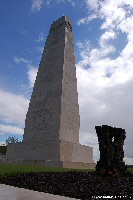
The 50th (Northumbrian) Division Memorial
On the two sides are listed the units which made up this Division, which were the 149th (Northumberland), 150th (York and Durham) and 151st (Durham Light Infantry) Infantry Brigades, plus associated cavalry, artillery and other Divisional units. The actual battalions listed within the infantry brigades do not in fact reflect all the units that were part of the 50th throughout the Great War.
The memorial was unveiled on Sunday the 1st of September 1929, by Field-Marshal Lord Plumer. It was designed by an officer who had served with the Division in the 9th Durham Light Infantry and won the Military Cross, Captain Mauchlen. Ex-soldiers and relatives of men who had fallen attended the ceremony, which was held at 11 a.m, and followed by the Last Post and a minutes silence.
A little further from Ypres in the same north-easterly direction is the village of St. Julien.
Sources & Acknowledgements
1901 Census records
Beatrix Brice: Battle Book of Ypres
Commonwealth War Graves Commission website
Great War Forum
Forum Eerste Wereldoorlog
Major & Mrs Holt: Battlefield Guide to the Ypres Salient
Michael Scott: The Ypres Salient
National Archives: WO 95/2308
The Times archives

